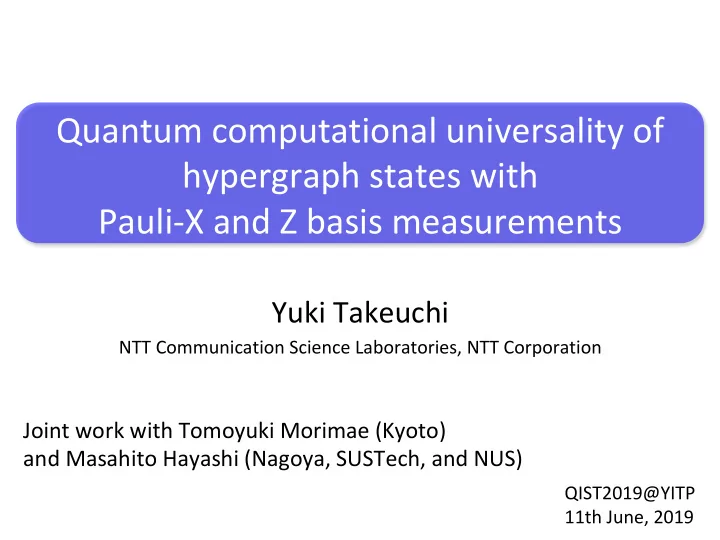

Quantum computational universality of hypergraph states with Pauli-X and Z basis measurements Yuki Takeuchi NTT Communication Science Laboratories, NTT Corporation Joint work with Tomoyuki Morimae (Kyoto) and Masahito Hayashi (Nagoya, SUSTech, and NUS) QIST2019@YITP 11th June, 2019
Measurement-based quantum computation • A universal quantum computing model proposed by R. Rasussebdorf and H. J. Briegel in 2001. • It is equivalent to the quantum circuit model.
<latexit sha1_base64="QGuCZT/4DwDB14DhWaTi/gq7iI=">AB6XicbVBNS8NAEJ3Ur1q/qh69LBbBU0lU0GOxF49V7Ae2oWy2m3bpZhN2J0IJ/QdePCji1X/kzX/jts1Bqw8GHu/NMDMvSKQw6LpfTmFldW19o7hZ2tre2d0r7x+0TJxqxpslrHuBNRwKRvokDJO4nmNAokbwfj+sxvP3JtRKzucZJwP6JDJULBKFrprv7QL1fcqjsH+Uu8nFQgR6Nf/uwNYpZGXCGT1Jiu5yboZ1SjYJPS73U8ISyMR3yrqWKRtz42fzSKTmxyoCEsbalkMzVnxMZjYyZRIHtjCiOzLI3E/zuimGV34mVJIiV2yxKEwlwZjM3iYDoTlDObGEMi3srYSNqKYMbTglG4K3/PJf0jqreudV9/aiUrvO4yjCERzDKXhwCTW4gQY0gUEIT/ACr87YeXbenPdFa8HJZw7hF5yPb0QtjS0=</latexit> <latexit sha1_base64="HsrEpC8VraJ6Tgc8GF3Sj5Nhw=">ACHXicbZDLSsNAFIYnXmu9RV26CRZBKJSkFnRZdOygr1AE8pkOmHTibpzEmhpH0RN76KGxeKuHAjvo3TNgt/WHg4z/nzMz5/ZgzBb9baytb2xubed28rt7+weH5tFxQ0WJLROIh7Jlo8V5UzQOjDgtBVLikOf06Y/uJ3VmyMqFYvEA4xj6oW4J1jACAZtdczKpOhKLHqcunSYsJFLAolJOrEztzhxMpqmrhpKSMvTacs2CV7LmsVnAwKFOtY363YgkIRVAOFaq7dgxeCmWwIi+Oe8misaYDHCPtjUKHFLlpfPtpta5drpWEl9BFhz9/dEikOlxqGvO0MfbVcm5n/1doJBNdeykScABVk8VCQcAsiaxaV1WSEuBjDZhIpv9qkT7W8YAONK9DcJZXoVGueRcluz7SqF6k8WRQ6foDF0gB12hKrpDNVRHBD2iZ/SK3own48V4Nz4WrWtGNnOC/sj4+gGhk6OA</latexit> Measurement-based quantum computation • A universal quantum computing model proposed by R. Rasussebdorf and H. J. Briegel in 2001. • It is equivalent to the quantum circuit model. | + i ⌘ | 0 i + | 1 i p 2 CZ Step 1. Prepare a universal resource state (e.g. 2D cluster state). (This step does not depend on what we want to compute.)
Measurement-based quantum computation • A universal quantum computing model proposed by R. Rasussebdorf and H. J. Briegel in 2001. • It is equivalent to the quantum circuit model. Step 1. Prepare a universal resource state (e.g. 2D cluster state). (This step does not depend on what we want to compute.) Step 2. Adaptively measure each qubit in an appropriate basis. (The measurement bases decide what we compute.)
<latexit sha1_base64="0wrDLxYi8cvbV4jF/y5QwlUezgk=">AB9XicbVBNS8NAEJ34WetX1aOXxSJ4KokKeix68VjBfkAby2Y7aZduNmF3o5TY/+HFgyJe/S/e/Ddu2xy09cHA470ZuYFieDauO63s7S8srq2Xtgobm5t7+yW9vYbOk4VwzqLRaxaAdUouMS64UZgK1FIo0BgMxheT/zmAyrNY3lnRgn6Ee1LHnJGjZXunzqJ5t2wo6jsC+yWym7FnYIsEi8nZchR65a+Or2YpRFKwTVu25ifEzqgxnAsfFTqoxoWxI+9i2VNItZ9Nrx6TY6v0SBgrW9KQqfp7IqOR1qMosJ0RNQM9703E/7x2asJLP+MySQ1KNlsUpoKYmEwiID2ukBkxsoQyxe2thA2oszYoIo2BG/+5UXSOK14ZxX39rxcvcrjKMAhHMEJeHABVbiBGtSBgYJneIU359F5cd6dj1nrkpPHMAfOJ8/64iSxg=</latexit> <latexit sha1_base64="8TAcbvY0GJgXmcnGkoEOfSQENE=">AB9XicdVDLSgMxFM34rPVdekmWARXQ6atY7srunFZwT6gM5ZMmlDM5khyShl7H+4caGIW/FnX9j+hBU9MCFwzn3cu89QcKZ0gh9WEvLK6tr67mN/ObW9s5uYW+/peJUEtokMY9lJ8CKciZoUzPNaSeRFEcBp+1gdDH127dUKhaLaz1OqB/hgWAhI1gb6ebeSxTrhZ7EYsBpr1BEdq2GKo4LkX2KUMmtGYLKparQsdGMxTBAo1e4d3rxySNqNCEY6W6Dkq0n2GpGeF0kvdSRNMRnhAu4YKHFHlZ7OrJ/DYKH0YxtKU0HCmfp/IcKTUOApMZ4T1UP32puJfXjfVYdXPmEhSTQWZLwpTDnUMpxHAPpOUaD42BPJzK2QDLHERJug8iaEr0/h/6RVsp2yja4qxfr5Io4cOARH4AQ4AzUwSVogCYgQIH8ASerTvr0XqxXuetS9Zi5gD8gPX2CVmgkxI=</latexit> Measurement-based quantum computation • A universal quantum computing model proposed by R. Rasussebdorf and H. J. Briegel in 2001. • It is equivalent to the quantum circuit model. | ψ f i Step 1. Prepare a universal resource state (e.g. 2D cluster state). (This step does not depend on what we want to compute.) Step 2. Adaptively measure each qubit in an appropriate basis. (The measurement bases decide what we compute.) Step 3. A desired output state is prepared:) | ψ f i
<latexit sha1_base64="0wrDLxYi8cvbV4jF/y5QwlUezgk=">AB9XicbVBNS8NAEJ34WetX1aOXxSJ4KokKeix68VjBfkAby2Y7aZduNmF3o5TY/+HFgyJe/S/e/Ddu2xy09cHA470ZuYFieDauO63s7S8srq2Xtgobm5t7+yW9vYbOk4VwzqLRaxaAdUouMS64UZgK1FIo0BgMxheT/zmAyrNY3lnRgn6Ee1LHnJGjZXunzqJ5t2wo6jsC+yWym7FnYIsEi8nZchR65a+Or2YpRFKwTVu25ifEzqgxnAsfFTqoxoWxI+9i2VNItZ9Nrx6TY6v0SBgrW9KQqfp7IqOR1qMosJ0RNQM9703E/7x2asJLP+MySQ1KNlsUpoKYmEwiID2ukBkxsoQyxe2thA2oszYoIo2BG/+5UXSOK14ZxX39rxcvcrjKMAhHMEJeHABVbiBGtSBgYJneIU359F5cd6dj1nrkpPHMAfOJ8/64iSxg=</latexit> Measurement-based quantum computation Step 1. Prepare a universal resource state (e.g. 2D cluster state). (This step does not depend on what we want to compute.) Step 2. Adaptively measure each qubit in an appropriate basis. (The measurement bases decide what we compute.) Step 3. A desired output state is prepared:) | ψ f i Step 2 is the only online operation in MBQC.
<latexit sha1_base64="0wrDLxYi8cvbV4jF/y5QwlUezgk=">AB9XicbVBNS8NAEJ34WetX1aOXxSJ4KokKeix68VjBfkAby2Y7aZduNmF3o5TY/+HFgyJe/S/e/Ddu2xy09cHA470ZuYFieDauO63s7S8srq2Xtgobm5t7+yW9vYbOk4VwzqLRaxaAdUouMS64UZgK1FIo0BgMxheT/zmAyrNY3lnRgn6Ee1LHnJGjZXunzqJ5t2wo6jsC+yWym7FnYIsEi8nZchR65a+Or2YpRFKwTVu25ifEzqgxnAsfFTqoxoWxI+9i2VNItZ9Nrx6TY6v0SBgrW9KQqfp7IqOR1qMosJ0RNQM9703E/7x2asJLP+MySQ1KNlsUpoKYmEwiID2ukBkxsoQyxe2thA2oszYoIo2BG/+5UXSOK14ZxX39rxcvcrjKMAhHMEJeHABVbiBGtSBgYJneIU359F5cd6dj1nrkpPHMAfOJ8/64iSxg=</latexit> Measurement-based quantum computation Step 1. Prepare a universal resource state (e.g. 2D cluster state). (This step does not depend on what we want to compute.) Step 2. Adaptively measure each qubit in an appropriate basis. (The measurement bases decide what we compute.) Step 3. A desired output state is prepared:) | ψ f i Step 2 is the only online operation in MBQC. It is theoretically and experimentally interesting to reduce the necessary number of measurement bases even if the initial state becomes (slightly) complex.
<latexit sha1_base64="0wrDLxYi8cvbV4jF/y5QwlUezgk=">AB9XicbVBNS8NAEJ34WetX1aOXxSJ4KokKeix68VjBfkAby2Y7aZduNmF3o5TY/+HFgyJe/S/e/Ddu2xy09cHA470ZuYFieDauO63s7S8srq2Xtgobm5t7+yW9vYbOk4VwzqLRaxaAdUouMS64UZgK1FIo0BgMxheT/zmAyrNY3lnRgn6Ee1LHnJGjZXunzqJ5t2wo6jsC+yWym7FnYIsEi8nZchR65a+Or2YpRFKwTVu25ifEzqgxnAsfFTqoxoWxI+9i2VNItZ9Nrx6TY6v0SBgrW9KQqfp7IqOR1qMosJ0RNQM9703E/7x2asJLP+MySQ1KNlsUpoKYmEwiID2ukBkxsoQyxe2thA2oszYoIo2BG/+5UXSOK14ZxX39rxcvcrjKMAhHMEJeHABVbiBGtSBgYJneIU359F5cd6dj1nrkpPHMAfOJ8/64iSxg=</latexit> Measurement-based quantum computation Step 1. Prepare a universal resource state (e.g. 2D cluster state). (This step does not depend on what we want to compute.) Step 2. Adaptively measure each qubit in an appropriate basis. (The measurement bases decide what we compute.) Step 3. A desired output state is prepared:) | ψ f i Step 2 is the only online operation in MBQC. It is theoretically and experimentally interesting to reduce the necessary number of measurement bases even if the initial state becomes (slightly) complex. (A part of) our results: We have constructed a universal resource state that only requires adaptive Pauli X and Z-basis measurements for universal MBQC.
<latexit sha1_base64="i1pRBGcbHqMdygrcpzlF0k96nIM=">ACAHicbVDJSgNBEO2JW4zbqAcPXhqD4MUwo4Ieg148RjALycTQ06kTXoWumuEMzFX/HiQRGvfoY3/8bOctDEBwWP96qoqufHUmh0nG8rt7S8srqWXy9sbG5t79i7ezUdJYpDlUcyUg2faZAihCoKlNCIFbDAl1D3hzdjv/4ISosovMdRDO2A9UPRE5yhkTr2ATykp8LDASCjTS9CEYCmzaxjF52SMwFdJO6MFMkMlY795XUjngQIpdM65brxNhOmULBJWQFL9EQMz5kfWgZGjKzp51OHsjosVG6tBcpUyHSifp7ImWB1qPAN50Bw4Ge98bif14rwd5VOxVhnCEfLqol0iKER2nQbtCAUc5MoRxJcytlA+YhxNZgUTgjv/8iKpnZXc85Jzd1EsX8/iyJNDckROiEsuSZnckgqpEk4y8kxeyZv1ZL1Y79bHtDVnzWb2yR9Ynz9PqpY3</latexit> <latexit sha1_base64="DhMW8SU1c9GmQjQms3oWDqlB7AU=">ACA3icbVDJSgNBEO2JW4zbqDe9NAYhHgwzUdBj0IvHCGYhi6GnU0ma9Cx01whCHjxV7x4UMSrP+HNv7GzHDTxQcHjvSq6nmRFBod59tKLS2vrK6l1zMbm1vbO/buXkWHseJQ5qEMVc1jGqQIoIwCJdQiBcz3JFS9wfXYrz6A0iIM7nAYQctnvUB0BWdopLZ9APfJqcgVmtgHZCe03gxR+KBpfdS2s07emYAuEndGsmSGUtv+anZCHvsQIJdM64brRNhKmELBJYwyzVhDxPiA9aBhaMDMnlYy+WFEj43Sod1QmQqQTtTfEwnztR76nun0Gfb1vDcW/MaMXYvW4kIohgh4NF3VhSDOk4ENoRCjKoSGMK2FupbzPFONoYsuYENz5lxdJpZB3z/LO7Xm2eDWLI0OyRHJEZdckCK5ISVSJpw8kmfySt6sJ+vFerc+pq0pazazT/7A+vwBloiW2A=</latexit> Several universal resource states Resource state Measurement basis Class X, Y, TXT † [16] Cluster state [15] graph state X, Y, TXT † [17] Brickwork state [17] graph state X, Z, H, XHX [18] Triangular lattice state [18] graph state Raussendorf-Harrington-Goyal (RHG) lattice [19, 20] X, Y, Z, TXT † [20, 21] graph state X, Y, TXT † [22] Decorated RHG lattice [22] graph state Affleck-Kennedy-Lieb-Tasaki (AKLT) state [23, 24] qutrit bases [24] matrix-product state X, Y, Z [25] Union Jack state [25] hypergraph state X, Y, Z [26] Three-uniform hypergraph state [26] hypergraph state X, Z [27] Mølmer-Sørensen graph state [27] weighted graph state X, Z Our state hypergraph state [Briegel et al. ‘01] [Rossi et al. ‘13] [Hartmann et al. ‘07] Ø Graph state Ø Hypergraph state Ø Weighted graph state e − i θ Z ⊗ Z = |+ 〉 = = CCZ e − i (2 θ ) Z ⊗ Z = CZ =
Recommend
More recommend